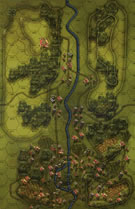| Author |
Matt W
|
| Method |
Solo |
| Victor |
Poland |
| Play Date |
2012-12-12 |
| Language |
English |
| Scenario |
PoSt001
|
In this scenario a large Polish armored force with some nasty Black Princes and even nastier Crocs and AVREs need to break through an RKKA defense loaded with AA, AT and tank destroyer support. The goal of the Poles is to break the crust and run for the exits. The Soviets want the Poles to stick around awhile. Unfortunately for the Soviets they just don't have the oomph to hold the Poles in place.
The Soviets see that the shortest route for the Poles is through the rural south end of the board and decide to place the majority of their serious weaponry there with belts of mines fronting them. They deploy a company of infatry with engineer support in the northern, more urban end of the board but also provide them with transport (trucks) to be able to move rapidly should the Poles ignore them.
The Poles, as projected approach the river with their weight in the south, cross the river and engage the entrenched Soviets. The early fighting greatly favors the Soviets and in the first hour step losses are 9-2 in their favor with heavy losses amongst the Polish engineers (note that the river is minor with no bridges - merely slowing down the Polish leg and mechanized forces but forming a complete boundary for the 17 pdrs as the only transport is motorized).
After shaking off the early losses the Poles get down to business on the Soviet first line, destroying 16 steps plus both steps of SU-100s in the next hour while losing only 3 steps and 1 step of Black Princes. After this it was merely a matter of cleaning up the battlefield. By the time turn 18 had finished the Poles had already exited 18 steps and had a 50 point lead in the scenario.
Despite the lopsided result I enjoyed the play quite a bit. The opporutunity to use these weapons in a scenario where the Poles have to move on is a blast. I anticipate a similar feeling with the scenarios in Patton's Nightmare as well as the upcoming Hammer & Sickle. The scenarios are typically large (this is one of the smaller ones) and have a variety of types of engagements. I give this one a "4" and look forward to the rest.
|





 PoEx015
PoEx015 
































